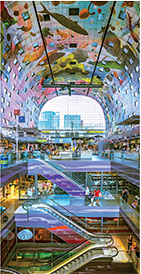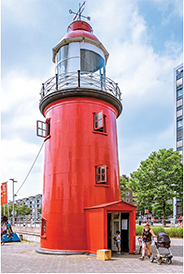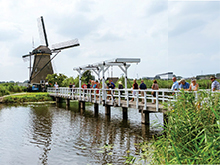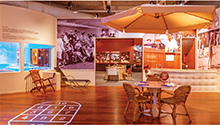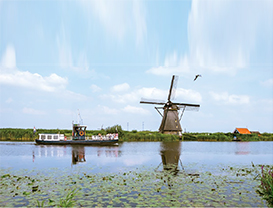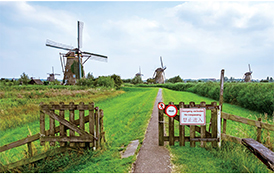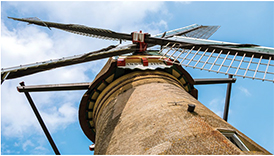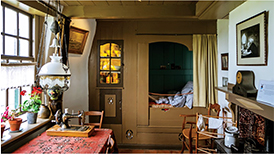A couple of blocks from Markthal, a huge building on the banks of a canal houses the famous Rotterdam Maritime Museum. While the replicas and stories of the ships are displayed inside, the canal outside has a mock lighthouse and some real boats on display. Each day, by rotation, one of these historically significant boats is opened up for visitors.
My half-day in Rotterdam was over. I made my way towards the Waterbus jetty. Waterbus is a comfortable ferry that takes 35 minutes to cover this 25-kilometre distance. During this ferry ride, you get a gorgeous view of Rotterdam’s cityscape. Since this canal is navigable, you would also spot cargo ships making their way towards Rotterdam Harbour.
Once the ferry docked at Kinderdijk, I followed the crowd towards the ticketing counter. Near the entrance, a signboard was proudly proclaiming Kinderdijk’s UNESCO Heritage Site status. Kinderdijk is a Dutch word that means Kid’s Dyke.
For those readers who may not remember – The Netherlands is thus named since the land is truly nether (low). Most coastal areas of the Netherlands lie around 7 metres below sea level. As keeping the seawater out was a priority, the Dutch came up with an intricate system of canals, dykes and windmills to keep the land dry.
Kinderdijk is one such cluster of canals and windmills. The natives built it in the year 1740 C. E. And this cluster continues to serve its original purpose of keeping the seawater out for over 275 years!
The entire cluster is spread over 79 acres (32 hectare) and all these windmills are functional even today. A native farming family owns each of these windmills privately – the only exception is one windmill that has now been converted into a museum to give the visitors a glimpse of the native farming lifestyle.
While the windmill’s mechanical parts dominate the interior, it still provides 3-storey living quarters to the farming family – from a functional kitchen to living room to bedrooms. As I went up the windmill museum and glanced around the topography, the sheer natural beauty of the landscape, dotted unobtrusively by these silent, solid structures, fascinated me.
After walking about the place till sunset, I took the Waterbus back to Rotterdam to get back to my Airbnb in Amsterdam. During this quiet journey, I was reflecting on how necessity truly becomes the mother of invention.
When you don’t have gills and need to keep the seawater out, you find truly innovative ways to pump out the water. And to imagine that this intricate system was invented over 275 years ago makes you marvel at the technological advancement of that era.
While you visit the Netherlands, take a day trip to this UNESCO-endorsed heritage site and experience the serene beauty for yourself! |SP

